Standard Uranium Intersects Elevated Radioactivity, Significant Structure and Alteration; and Completes Winter Drill Program at Sun Dog
Vancouver, British Columbia, April 03, 2023 — Standard Uranium Ltd. (“Standard Uranium” or the “Company”) (TSX-V: STND) (OTCQB: STTDF) (Frankfurt: FWB:9SU) is pleased to announce that the winter drill program at its 100% owned Sun Dog Project (“Sun Dog” or “the Project”) has been completed and crews demobilized prior to ice road closure April 1st. Sun Dog is located at the northwestern edge of the Athabasca Basin, Saskatchewan, and is south of the first uranium mining camp in Canada, the Beaverlodge District, near Uranium City.
Key Focus Points:
- Elevated radioactivity over a total of 1.5 metres up to 1,300 counts per second (cps)* intersected in drill hole SD-23-013 at the Haven discovery.
- Significant structure and alteration intersected in drill holes SD-23-011 and SD-23-012 at the Walli showing, including dravite-clay alteration halo associated with oxidized fault breccia and shear zones.
- Quartz-hematite breccias and dravite alteration intersected on Stewart Island in drill hole SD-23-010.
- Winter 2023 drilling intersected several characteristics of a uranium-bearing mineralized system in previously untested target areas, extending the known footprint of dravite and clay alteration associated with uranium mineralization in the Haven and Walli target areas.
- Sun Dog diamond drill program completed on March 31st, totalling 1,227.1 metres (m).
- Follow-up drill holes and new mainland target areas are planned to be tested during a possible fall 2023 program.
The Sun Dog project boasts all the favorable characteristics to host a high-grade, Athabasca-style unconformity-related uranium deposits, and the results of the second drill program on the project have strengthened the validity of the exploration model. Priority follow up targets are being planned as geological data from the winter 2023 program is processed and interpreted. Continuing exploration plans for the project include a supplementary bedrock mapping and sampling program in Q3 2023, leading into a possible follow up exploration drill program in fall 2023.
“I want to thank the geologists, drillers and all participants at the Sun Dog camp for their perseverance and dedication to complete this drill program under the extremely challenging winter conditions they faced this season,” said Standard Uranium’s President and CEO Jon Bey. “It is fantastic to see the results from the drill program that highlight that we are into a great alteration system that continues to improve with each exploration program. Our geologists are excited to get back to Sun Dog and it looks promising that we will add a second drill program focused on our Haven discovery and other Sun Dog land targets in the fall of 2023. I would also like to extend our appreciation to the local First Nations and northern communities for their cooperation and collaboration in the execution of our exploration efforts. We were once again pleased to host Ya’ thi Néné representatives during the program.”
The winter 2023 drill program at Sun Dog was designed to follow up on the results of the winter 2022 drill program on the 18,101-hectare property, in addition to historical drill hole results and perched uranium mineralization present at surface in rock outcrop. Drill targets focused on several gravity-low and resistivity anomalies coinciding with breaks or flexures in electromagnetic (EM) conductors under Athabasca sandstone cover, in addition to testing down-dip extents of high-grade** mineralization mapped at surface (Figure 1).
Sun Dog – Winter 2023 Drill Program Highlights
- SD-23-013; Haven discovery (Figure 3 & 4):
- Down-dip follow up of fault-controlled off-scale*** (65,535 cps) surface mineralization at the Haven discovery
- Significant structure and oxidation front alteration (hematite-limonite) from the top of hole to 33.5 m
- Elevated radioactivity from 79.0 to 80.0 m up to 1,300 cps (1,000 cps on handheld RS-125), and from 83.0 to 83.5 m up to 505 cps (320 cps on handheld RS-125), associated with a 10.25 m wide oxidized fault breccia and clay-dravite alteration
- Several additional intervals of quartz-hematite breccias
- SD-23-012; Walli showing (Figure 5):
- Down-dip follow up of surface mineralization up to 45,000 cps west along strike of hole SD-23-011
- Several intervals of quartz-hematite breccia and sheared metapelite
- No significant radioactivity
- SD-23-011; Walli showing (Figure 5):
- Down-dip follow up of surface mineralization up to 45,000 cps at the Walli showing
- Several intervals of oxidized fault zones and quartz-hematite breccias
- Dravite-clay-chlorite alteration is present throughout structural zones
- Graphitic shear zones in deformed metapelite
- No significant radioactivity
- SD-23-010; Stewart Island showing (Figure 1):
- 80 m step out west along strike from mineralization (61,000 cps) at surface and down-dip test of mineralization up to 7,400 cps at surface.
- Locally strong bleaching and fracture-controlled clay alteration in Athabasca sandstone
- Possible fracture-controlled dravite associated with several quartz-hematite breccias in basement rock
- No significant radioactivity
- SD-23-006; J-Bay target (Figure 1):
- 343 m step out southeast of mineralized drill hole LAI-05, targeting the confluence of several conductors within a gravity low gradient
- Possible dravitic-clay intersected within Athabasca sandstone at 63 m
- Numerous metre-scale brittle-reactivated shear zones with moderate to strong graphite
- No significant radioactivity encountered
“The results of this program coupled with the encouraging results of the inaugural 2022 program confirm that we have a significant alteration system and structural framework on the property with the ideal conditions for high-grade uranium mineralization,” said Sean Hillacre, Standard Uranium’s VP of Exploration. “The scale and intensity of deformation we are seeing in our first holes at Walli and Haven is spectacular, and paired with the alteration types intersected, we are confident it is only a matter of time until we vector into something even more exciting. The identification of a robust dravite-clay-iron oxide alteration system on Johnston Island, corresponding with elevated radioactivity at shallow depths emphasizes we are on the right track to continued discovery on the project.”
Table 1. Winter 2023 drill hole collar summary. Easting and Northing coordinates are reported in UTM Zone 12N, NAD83 datum; EOH = end of hole; m.a.s.l. = metres above sea level.
|
DDH |
Target Area |
Easting |
Northing |
Elevation (m.a.s.l.) |
Azimuth (°) |
Dip (°) |
EOH (m) |
|
SD-23-005 |
Java |
611832.000 |
6580303.200 |
214.00 |
010.00 |
-70.00 |
37.80 |
|
SD-23-005A |
Java |
611832.000 |
6580303.200 |
214.00 |
010.00 |
-70.00 |
34.00 |
|
SD-23-006 |
J-Bay |
612607.787 |
6578363.152 |
214.00 |
010.00 |
-70.10 |
415.85 |
|
SD-23-007 |
Skye |
618283.000 |
6577997.800 |
214.00 |
354.80 |
-69.80 |
60.75 |
|
SD-23-008 |
Java |
611780.290 |
6580283.600 |
214.00 |
000.00 |
-90.00 |
36.00 |
|
SD-23-009 |
J-Bay |
612271.500 |
6578872.700 |
214.00 |
014.90 |
-69.90 |
30.00 |
|
SD-23-010 |
Stewart Island |
619799.210 |
6578479.780 |
215.96 |
339.60 |
-51.60 |
186.00 |
|
SD-23-011 |
Walli |
613550.050 |
6578589.770 |
222.28 |
000.50 |
-55.00 |
143.50 |
|
SD-23-012 |
Walli |
613550.050 |
6578589.770 |
222.28 |
330.30 |
-51.60 |
129.70 |
|
SD-23-013 |
Haven |
613409.780 |
6577975.790 |
249.57 |
342.20 |
-51.60 |
153.50 |
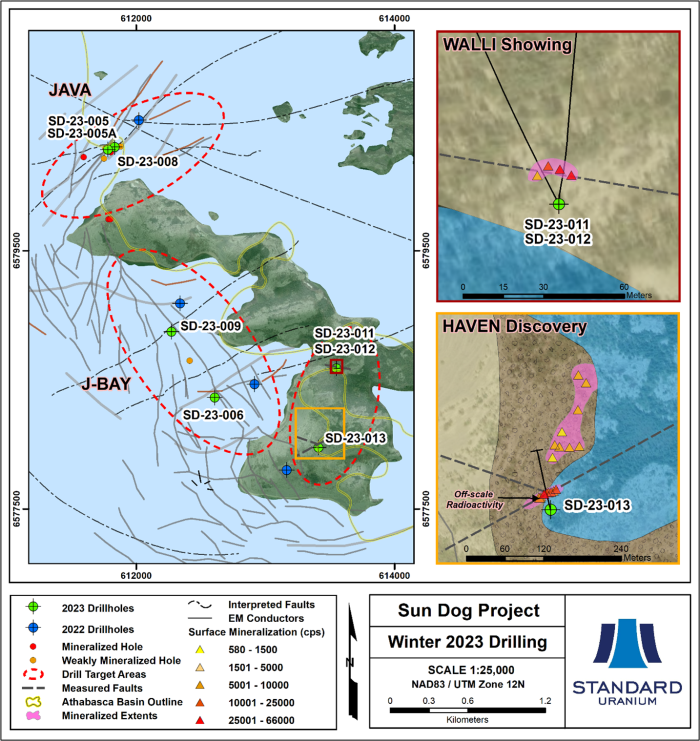
Figure 1. Plan map of winter 2023 drill collars at Johnston Island in context of historical drill holes, geophysical and radioactivity anomalies, and EM conductors
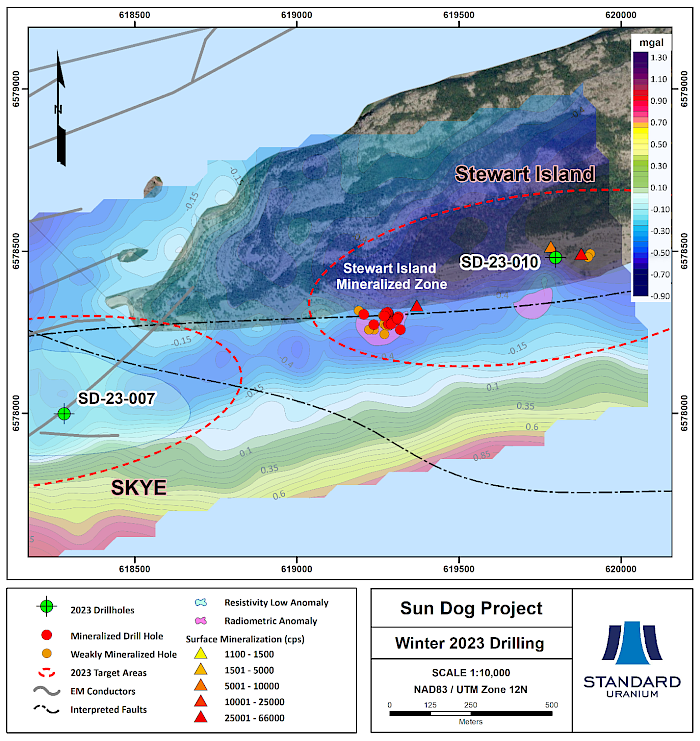
Figure 2. Plan map of winter 2023 drill collars at Stewart Island in context of historical drill holes, geophysical and radioactivity anomalies, and EM conductors.
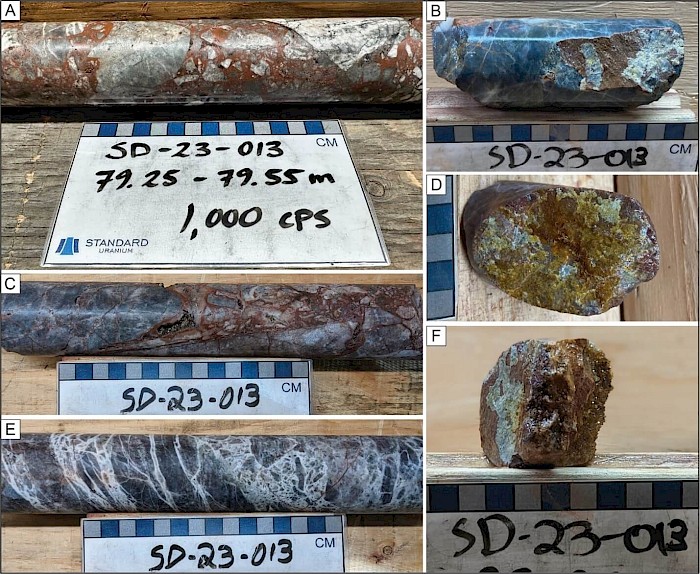
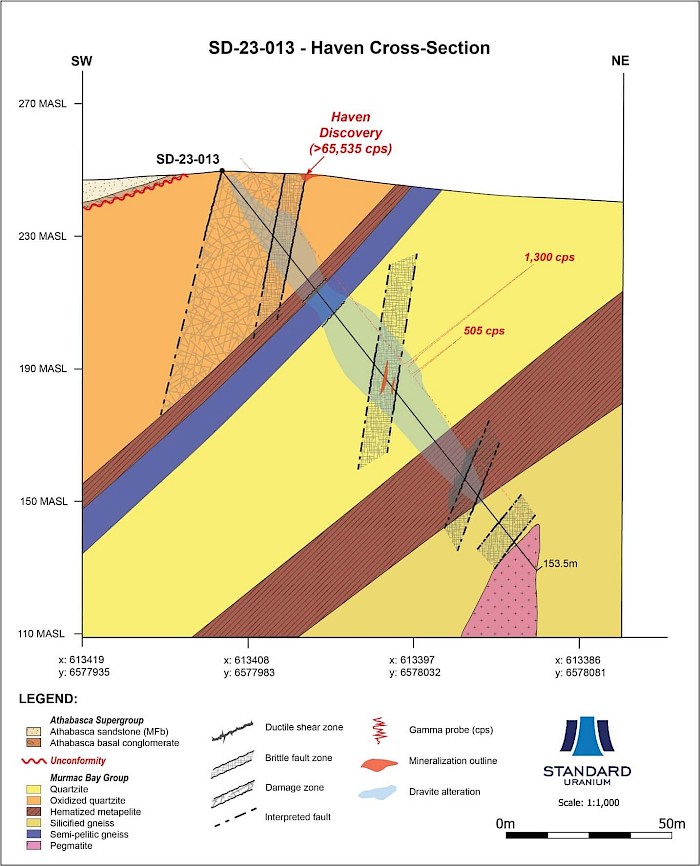
Figure 4. Schematic cross-section of drill hole SD-23-013 at the Haven discovery showing generalized geology and downhole 32GR gamma probe peaks from elevated radioactivity.
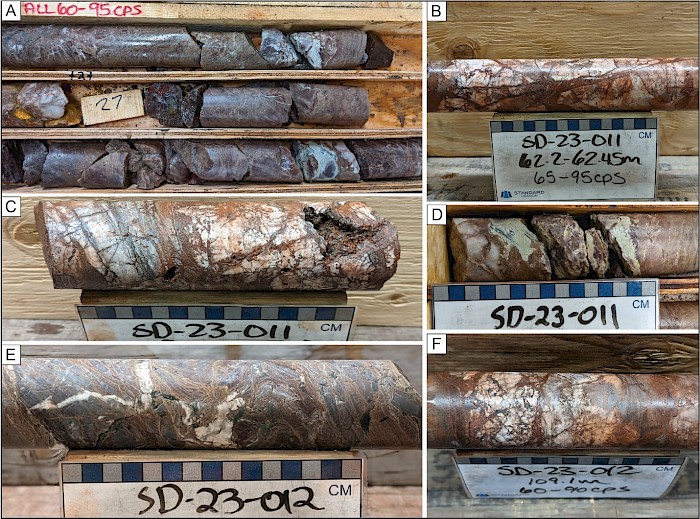
Drilling for the winter exploration program at Sun Dog commenced on March 3rd, 2023, after startup delays due to extreme weather fluctuations, and crews demobilized on March 31st prior to closure of the provincial ice road on April 1st.
The Company is also planning inaugural drill programs on its East Side projects, in addition to the flagship Davidson River project in 2023. Prospective results from exploration work completed in 2022 have provided compelling targets for high-grade uranium, and high-priority target areas have been identified in concert with artificial intelligence analysis of geophysical and geochemical data by ALS Goldspot Discoveries Ltd.
Samples collected for analysis are sent to Saskatchewan Research Council Geoanalytical Laboratories (“SRC”) in Saskatoon, Saskatchewan for preparation, processing and ICP-MS multi-element analysis using total and partial digestion, gold by fire assay and boron by fusion. Sandstone samples were tested using the ICP-MS1 uranium multi-element exploration package plus boron. Basement samples were tested with ICP-MS2 uranium multi-element exploration package plus boron. All sandstone samples, and basement samples marked as radioactive upon arrival to the lab were also analyzed using the U3O8 assay (reported in wt %). Basement rock split interval samples range from 0.1 to 0.5 m and sandstone composite samples are comprised of multiple equal sized full core “pucks” spaced over the sample interval. SRC is an ISO/IEC 17025/2005 and Standards Council of Canada certified analytical laboratory. Blanks, standard reference materials, and repeats were inserted into the sample stream at regular intervals in accordance with Standard Uranium’s quality assurance/quality control (QA/QC) protocols. Samples containing clay alteration have been sent to Rekasa Rocks Inc. in Saskatoon, Saskatchewan to be analyzed by Short Wavelength Infrared Reflectance (“SWIR”) via a Portable Infrared Mineral Analyzer (“PIMA”) to verify clay species. Geochemical assay results will be released as they are received and examined by the technical team in accordance with the Company’s internal quality control process.
*Natural gamma radiation in diamond drill core reported in this news release was measured in counts per second (cps) using a handheld RS-125 super-spectrometer and verified using a down-hole Mount Sopris 32GR slim gamma probe. The 32GR gamma probe has been calibrated to optimize the probe for uranium exploration logging and estimating weight percent U3O8 content. Readers are cautioned that scintillometer and gamma probe readings are not uniformly or directly related to uranium grades of the rock sample measured and should be treated only as a preliminary indication of the presence of radioactive minerals. All drill hole intersections are down-hole. Core interval measurements and true thicknesses are yet to be determined.
**The Company considers uranium mineralization with concentrations greater than 1.0 wt% U3O8 to be “high-grade”.
***The Company refers to off-scale as any intersection of radioactivity reaching 65,535 counts per second or greater on a Radiation Solutions handheld RS-125 superspec or RS-120 superscint.
The scientific and technical information contained in this news release, including the sampling, analytical and test data underlying the technical information contained in this news release, has been reviewed, verified, and approved by Sean Hillacre, P.Geo., VP Exploration of the Company and a “qualified person” as defined in NI 43-101.
About Standard Uranium (TSX-V: STND)
We find the fuel to power a clean energy future
Standard Uranium is a uranium exploration company with a focus on the world-class Athabasca Basin in Saskatchewan, Canada. Since its establishment, Standard Uranium has focused on the identification and exploration of Athabasca-style uranium targets with a view to discovery and future development.
Standard Uranium's Sun Dog project, in the northwest part of the Athabasca Basin, Saskatchewan, is comprised of six mineral claims over 18,101 hectares. The Sun Dog project is highly prospective for basement and unconformity hosted uranium deposits yet remains largely untested by sufficient drilling despite its location proximal to uranium discoveries in the area.
Standard Uranium’s Davidson River Project, in the southwest part of the Athabasca Basin, Saskatchewan, comprises eight mineral claims over 30,737 hectares. Davidson River is highly prospective for basement-hosted uranium deposits due to its location along trend from recent high-grade uranium discoveries. However, owing to the large project size with multiple targets, it remains broadly under-tested by drilling. Recent intersections of wide, structurally deformed and strongly altered shear zones provide significant confidence in the exploration model and future success is expected.
Standard Uranium’s Atlantic, Canary, and Ascent Projects, in the northeast Athabasca Basin, comprise nine mineral claims over 13,215 hectares. The eastern basin projects are highly prospective for unconformity-related uranium deposits based on historical uranium occurrences, recently identified geophysical anomalies, and location along trend from several high-grade uranium discoveries.
For further information contact:
Jon Bey, Chief Executive Officer, and Chairman
550 Denman Street, Suite 200
Vancouver, BC V6G 3H1
Tel: 1 (306) 850-6699
E-mail: info@standarduranium.ca
Cautionary Statement Regarding Forward-Looking Statements
This news release contains “forward-looking statements” or “forward-looking information” (collectively, “forward-looking statements”) within the meaning of applicable securities legislation. All statements, other than statements of historical fact, are forward-looking statements and are based on expectations, estimates and projections as of the date of this news release. Forward-looking statements include, but are not limited to, statements regarding: the timing and content of upcoming work programs; geological interpretations; timing of the Company’s exploration programs; and estimates of market conditions.
Forward-looking statements are subject to a variety of known and unknown risks, uncertainties and other factors that could cause actual events or results to differ from those expressed or implied by forward-looking statements contained herein. There can be no assurance that such statements will prove to be accurate, as actual results and future events could differ materially from those anticipated in such statements. Certain important factors that could cause actual results, performance or achievements to differ materially from those in the forward-looking statements are highlighted in the “Risks and Uncertainties” in the Company’s management discussion and analysis for the fiscal year ended April 30, 2022, dated August 26, 2022.
Forward-looking statements are based upon a number of estimates and assumptions that, while considered reasonable by the Company at this time, are inherently subject to significant business, economic and competitive uncertainties and contingencies that may cause the Company’s actual financial results, performance, or achievements to be materially different from those expressed or implied herein. Some of the material factors or assumptions used to develop forward-looking statements include, without limitation: the future price of uranium; anticipated costs and the Company’s ability to raise additional capital if and when necessary; volatility in the market price of the Company’s securities; future sales of the Company’s securities; the Company’s ability to carry on exploration and development activities; the success of exploration, development and operations activities; the timing and results of drilling programs; the discovery of mineral resources on the Company’s mineral properties; the costs of operating and exploration expenditures; the presence of laws and regulations that may impose restrictions on mining; employee relations; relationships with and claims by local communities and indigenous populations; availability of increasing costs associated with mining inputs and labour; the speculative nature of mineral exploration and development (including the risks of obtaining necessary licenses, permits and approvals from government authorities); uncertainties related to title to mineral properties; assessments by taxation authorities; fluctuations in general macroeconomic conditions.
The forward-looking statements contained in this news release are expressly qualified by this cautionary statement. Any forward-looking statements and the assumptions made with respect thereto are made as of the date of this news release and, accordingly, are subject to change after such date. The Company disclaims any obligation to update any forward-looking statements, whether as a result of new information, future events or otherwise, except as may be required by applicable securities laws. There can be no assurance that forward-looking statements will prove to be accurate, as actual results and future events could differ materially from those anticipated in such statements. Accordingly, readers should not place undue reliance on forward-looking statements.
Neither the TSX-V nor its Regulation Services Provider (as that term is defined in the policies of the TSX-V) accepts responsibility for the adequacy or accuracy of this release.
